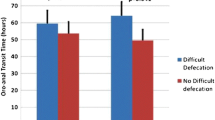Abstract
PURPOSE: Constipation is a common complaint; however, clinical presentation varies with each individual. The aim of this study was to assess a standard scoring system for evaluation of constipated patients. MATERIALS AND METHODS: All consecutive patients with idiopathic constipation who were referred for anorectal physiologic testing were assessed. A subjective constipation score was calculated based on a detailed questionnaire that included over 100 constipation-related symptoms. Based on the questionnaire, scores ranged from 0 to 30, with 0 indicating normal and 30 indicating severe constipation. The constipation score was then compared with the objective findings of the physiology tests, which include colonic transit time (CTT), anal manometry (AM), cinedefecography (CD), and electromyography (EMG). Colonic inertia was defined as diffuse marker delay on CTT without evidence of paradoxical contraction on AM, CD, or EMG. Pelvic outlet obstruction was defined as paradoxical puborectalis contraction, rectal prolapse or rectoanal intussusception, rectocele, or sigmoidocele. RESULTS: A total of 232 patients (185 females and 47 males) of a mean age of 64.9 (range, 14–92) years were evaluated. All patients had a score of more than 15; on evaluation of the significance of different symptoms in the constipation score with the Pearson's linear correlation test, 8 of 18 factors were identified as significant (P<0.05). These factors included frequency of bowel movements, painful evacuation, incomplete evacuation, abdominal pain, length of time per attempt, assistance for evacuation, unsuccessful attempts for evacuation per 24 hours, and duration of constipation. All 232 patients had objective obstruction attributable to one or more of the following causes: paradoxical puborectalis contraction (81), significant rectocele or sigmoidocele (48), rectoanal intussusception (64), and rectal prolapse (9). CONCLUSION: The proposed constipation scoring system correlated well with objective physiologic findings in constipated patients to allow uniformity in assessment of the severity of constipation.
Similar content being viewed by others
References
Wexner SD, Jagelman DG. Constipation. Postgrad Adv Colorectal Surg 1989;1:1–22.
Whitehead WE, Chaussade S, Corazziari E, Kumar D. Report of an international workshop on management of constipation. Int J Gastroenterol 1991;4:99–113.
Sonnenberg A, Koch TR. Epidemiology of constipation in the United States. Dis Colon Rectum 1989;32:1–8.
Manning AP, Thompson AG, Heaton KW, Morris AF. Toward positive diagnosis of the irritable bowel. BMJ 1978;2:653–4.
Jorge JM, Wexner SD. Etiology and management of fecal incontinence. Dis Colon Rectum 1993;36:77–97.
Wexner SD, Marchetti F, Salanga VD, Corredor C, Jagelman DG. Neurophysiologic assessment of the anal sphincters. Dis Colon Rectum 1991;34:606–12.
Wexner SD, Marchetti F, Jagelman DG. The role of sphincteroplasty for fecal incontinence reevaluated: a prospective physiologic and functional review. Dis Colon Rectum 1991;34:22–30.
Hinton JM, Lennard-Jones JE, Young AC. A new method for studying gut transit times using radioopaque markers. Gut 1969;10:842–7.
Kuijpers JH, Bleijenberg G. The spastic pelvic floor syndrome: a cause of constipation. Dis Colon Rectum 1985;28:669–72.
van Tets WF, Kuijpers JH. Internal rectal intussusception—fact or fancy? Dis Colon Rectum 1995;38:1080–3.
Hoffman MJ, Kodner IJ, Fry RD. Internal intussusception of the rectum: diagnosis and surgical management. Dis Colon Rectum 1984;27:435–41.
Johansson C, Nilsson BY, Holström B, Dolk A, Mellgren A. Association between rectocele and paradoxical sphincter response. Dis Colon Rectum 1992;35:503–9.
Frykman HM, Goldberg SM. The surigal treatment of rectal procidentia. Surg Gynecol Obstet 1969;129:1225–30.
Jorge JM, Wexner SD, Marchetti F, Rosato GO, Sullivan M, Jagelman DG. How reliable are currently available methods of measuring the anorectal angle? Dis Colon Rectum 1992;35:332–8.
Jorge JM, Yang Y-K, Wexner SD. Incidence and clinical significance of sigmoidoceles as determined by a new classification system. Dis Colon Rectum 1994;37:1112–7.
Moore-Gillon V. Constipation: what does the patient mean? J R Soc Med 1984;77:108–10.
MacDonald A, Baxter JN, Finlay IG. Idiopathic slow transit constipation. Br J Surg 1993;80:1107–11.
Drossman DA, Sandler RS, McKee DC, Lovitz AJ. Bowel patterns among subjects not seeking health care. Gastroenterology 1982;83:529–34.
Thompson WG, Heaton KW. Functional bowel disorders in apparently healthy people. Gastroenterology 1980;79:283–8.
Devroede G, Roy T, Bouchoucha M,et al. Idiopathic constipation by colonic dysfunction: relationship with personality and anxiety. Dig Dis Sci 1989;34:1428–33.
Heymen S, Wexner SD, Gulledge AD. MMPI assessment of patients with functional bowel disorders. Dis Colon Rectum 1993;36:593–6.
Wald A, Burgio K, Holeva K, Locher J. Psychological evaluation of patients with severe idiopathic constipation: which instrument to use. Am J Gastroenterol 1992;87:977–80.
Wald A, Hinds JP, Caruana BJ. Psychological and physiological characteristics of patients with severe idiopathic constipation. Gastroenterology 1989;97:932–7.
Grotz RL, Pemberton JH, Talley NJ, Rath DM, Zinsmeister AR. Discriminant values of psychological distress, symptom profiles, and segmentai colonic dysfunction in out patients with severe idiopathic constipation. Gut 1994;35:798–802.
Pemberton JH, Rath DM, Ilstrup DM. Evaluation and surgical treatment of severe constipation. Ann Surg 1991;214:403–11.
Author information
Authors and Affiliations
About this article
Cite this article
Agachan, F., Chen, T., Pfeifer, J. et al. A constipation scoring system to simplify evaluation and management of constipated patients. Dis Colon Rectum 39, 681–685 (1996). https://doi.org/10.1007/BF02056950
Issue Date:
DOI: https://doi.org/10.1007/BF02056950




